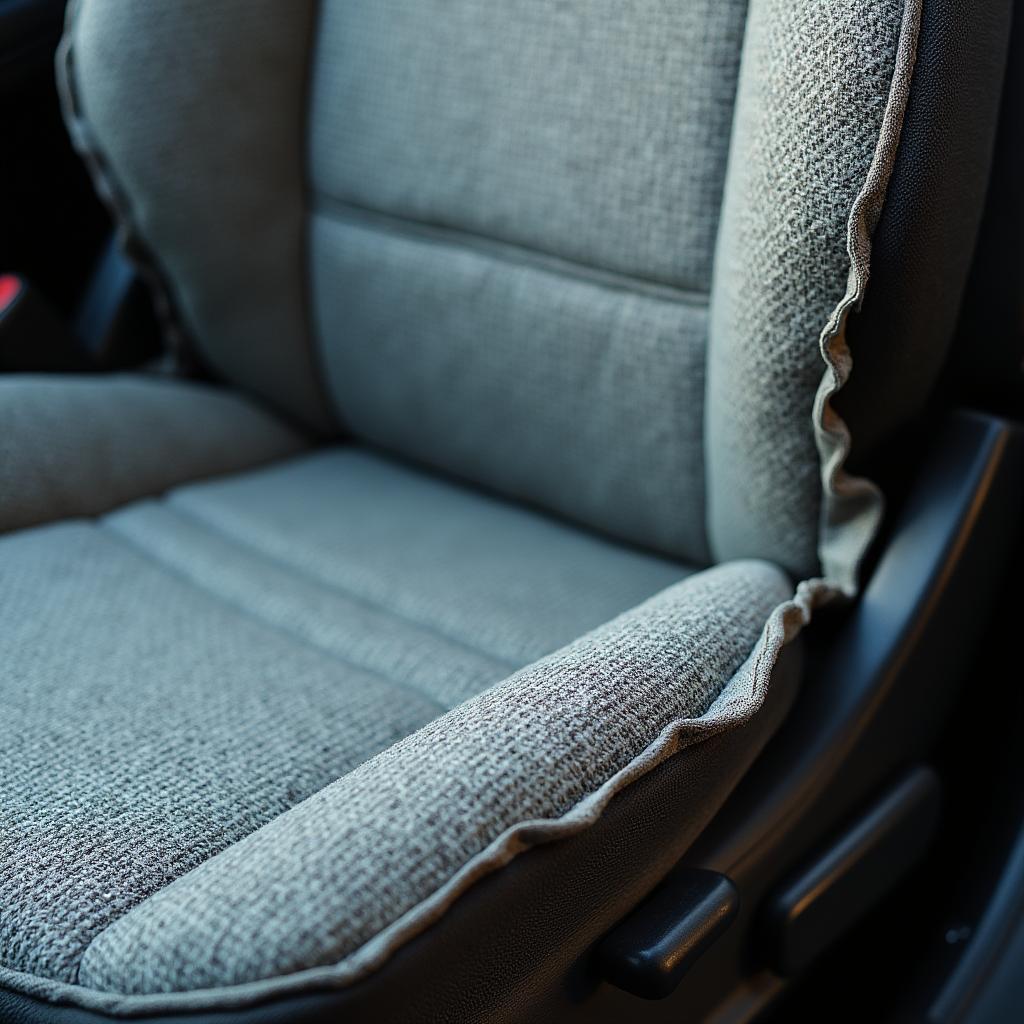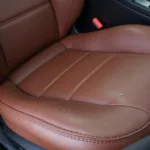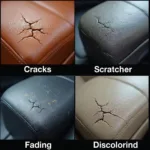A torn car seat can be an eyesore and detract from the overall appearance of your vehicle’s interior. But before you consider expensive reupholstery, there are several DIY methods you can use to repair torn car seat fabric and restore your car’s interior to its former glory.
Assessing the Damage: Know Your Enemy
Before diving into the repair, it’s crucial to assess the severity of the tear. A small cut will require a different approach than a large rip with frayed edges. Consider the fabric type, the location of the tear, and whether it’s a clean cut or a frayed tear. This assessment will help you determine the best repair method and gather the necessary materials.
Gather Your Arsenal: Tools and Materials
Having the right tools and materials is crucial for a successful repair. Here’s a list of items you’ll need:
- Cleaning Supplies: A vacuum cleaner with a crevice attachment, rubbing alcohol, microfiber cloths, and mild soap.
- Repair Materials: Depending on the method you choose, you will need either a fabric repair kit, a needle and thread that match your fabric, fabric glue, or a liquid leather repair kit (for leather or vinyl seats).
- Additional Tools: Scissors, tweezers, masking tape, and a hairdryer (optional).
Choosing the Right Repair Method
The best method for repairing your torn car seat fabric will depend on the size and type of damage. Here are three common techniques:
1. Sewing: The Classic Approach for Minor Tears
For small tears or cuts with clean edges, sewing is often the most effective method.
- Clean the Area: Use a vacuum cleaner to remove any dirt or debris. Then, clean the area around the tear with rubbing alcohol and allow it to dry completely.
- Thread Your Needle: Choose a thread color that closely matches your fabric and thread your needle. Tie a knot at the end of the thread.
- Sew the Tear: Carefully align the edges of the tear and start sewing from the inside of the fabric. Use small, straight stitches to close the gap.
- Secure the Stitch: Once you reach the end of the tear, tie off the thread with a secure knot and trim any excess.
2. Fabric Glue: Quick and Easy for Small Tears
Fabric glue offers a convenient alternative to sewing, especially for small, clean tears.
- Prepare the Area: Clean the area around the tear as described in the sewing method.
- Apply the Glue: Apply a thin layer of fabric glue to the edges of the tear. Be careful not to use too much glue, as it can bleed through the fabric.
- Press and Hold: Press the edges of the tear together firmly and hold for the amount of time specified in the glue’s instructions.
- Allow to Dry: Allow the glue to dry completely before using the seat.
3. Fabric Repair Kits: The All-in-One Solution
Fabric repair kits are ideal for larger tears or tears with frayed edges. These kits typically include a patch, adhesive backing, and an iron-on application.
- Clean the Area: Thoroughly clean the area around the tear.
- Apply the Patch: Cut the patch to a size slightly larger than the tear, peel off the adhesive backing, and carefully apply it to the underside of the tear.
- Iron-On Application: Place a thin cloth over the patch and use an iron on a low setting to heat the adhesive, bonding the patch to the fabric.
- Check Adhesion: Allow the patch to cool completely and check its adhesion. If needed, repeat the ironing process.
“Remember, prevention is key,” says automotive expert John Smith, “Regularly cleaning and conditioning your car seats can help prevent tears and cracks from forming in the first place.”
Special Considerations: Leather and Vinyl Seats
For tears in leather or vinyl seats, it’s best to use a liquid leather repair kit. These kits typically include a color matching system, filler paste, and a sealant.
- Clean the Area: Clean the area around the tear with a leather cleaner and allow it to dry completely.
- Fill the Tear: If the tear is deep, use the filler paste to fill the gap and create a smooth surface.
- Apply the Liquid Leather Repair: Following the kit’s instructions, apply the liquid leather repair to the damaged area, blending it in with the surrounding material.
- Allow to Dry: Allow the repair to dry completely. You may need to apply multiple coats for best results.
“When working with leather, it’s essential to use products specifically designed for leather care,” advises Smith, “Using harsh chemicals or cleaners can damage the material and worsen the tear.”
Preventing Future Tears: Prolonging the Life of Your Car Seats
Repairing a torn car seat is a great way to restore your car’s interior, but taking steps to prevent future tears is equally important. Here are some tips to keep your car seats looking their best:
- Regular Cleaning: Vacuum your car seats regularly to remove dirt and debris that can cause wear and tear.
- Use Seat Covers: Seat covers provide an extra layer of protection, especially if you frequently transport children or pets.
- Avoid Sharp Objects: Be mindful of sharp objects that could potentially puncture or tear your seats.
- Address Spills Promptly: Clean up any spills immediately to prevent stains and damage to the fabric.
Conclusion: Torn Car Seat Fabric Doesn’t Have to Be a Disaster
Repairing a torn car seat fabric is a manageable task that can save you time and money compared to professional reupholstery. By carefully assessing the damage, choosing the appropriate repair method, and following the steps outlined in this guide, you can restore your car’s interior to its former glory. And remember, regular maintenance and preventative measures can go a long way in prolonging the life of your car seats and keeping them looking their best for years to come.
Do you have any more questions about how to repair torn car seat fabric? We’ve compiled some frequently asked questions below:
FAQs:
1. Can I use super glue to repair a tear in my car seat fabric?
While super glue might seem like a quick fix, it’s not recommended for car seat fabric repairs. Super glue can create a stiff, inflexible bond that is prone to cracking and peeling over time. It can also discolor the fabric and make future repairs more difficult.
2. How can I prevent my car seats from fading in the sun?
UV rays from the sun can cause car seat fabric to fade over time. Use a sunshade when parking your car outdoors, and consider treating your seats with a UV protectant spray designed for fabric or leather.
3. What’s the best way to clean stubborn stains on my car seats?
For stubborn stains, it’s best to use a dedicated car upholstery cleaner or consult a professional detailer. Avoid using harsh chemicals or abrasive cleaners, as these can damage the fabric.
4. My car seat has a burn hole. Can I repair it myself?
Repairing a burn hole in car seat fabric is a more complex task that often requires professional attention. Attempting to repair it yourself could worsen the damage.
5. How much does it cost to have a car seat professionally reupholstered?
The cost of car seat reupholstery can vary widely depending on factors such as the type of fabric, the complexity of the job, and your location.
Looking for more car repair advice? Check out these helpful articles:
- How to repair black leather car seat
- How can I repair my leather car seats
- How to repair cracking leather car seats
- How to repair peeling leather car seat
- How do I repair leather car seats
Need personalized assistance with your car repair needs? Contact our team of experts via WhatsApp: +1(641)206-8880 or email: [email protected]. We’re here to help you 24/7!



